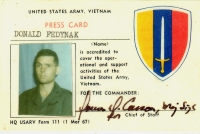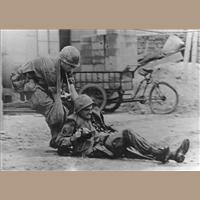 -
An Image of War -
-
An Image of War -
Webmaster's comments: Donald Fedynak was a member of
the last Signal OCS class of the Vietnam War era, Class 04-68. Class 04-68
graduated in February, 1968. His insight and reflections in the following
article show how a world of chaos swirled around all those who served then, as
the U.S. began the massive task of winding down from one of its longest wars.
While on the surface all was quiet as Officers like Fedynak tried to build their
career, in South East Asia a great army, the U.S. Army, was beginning its return
to barracks, with a wary eye over its shoulder towards the enemy it was leaving
behind, and an even keener eye towards those it was marching towards... those on
the home front that blamed it for mistakes made in Washington.
The upheaval surrounding the end of the Vietnam War
stalled many a young Officer's dreams. Six years of hard work in learning a
craft and building a military career went down the drain as the Army downsized.
Six years of dedication to one's country were passed off as inconsequential
skills, as Officers everywhere found themselves slowly being forced to return to
civilian life. Read between the lines in the following story, and you may see
your own history come alive again.
- - - - -
 Recently, I posted a photo on the website “The Virtual Wall,” as a way
to graphically honor the heroism of a fellow soldier and
221st combat photographer.
(See:
http://www.virtualwall.org/dc/CyrRC01a.htm, also see photo at bottom
of page).
I’d served with the same unit in Vietnam, the 221st Signal Company
(Pictorial) Southeast Asia Pictorial Center (SEAPC), as a Signal Photo Officer,
a year after the photo was taken. (Click
to enlarge picture at right)
Recently, I posted a photo on the website “The Virtual Wall,” as a way
to graphically honor the heroism of a fellow soldier and
221st combat photographer.
(See:
http://www.virtualwall.org/dc/CyrRC01a.htm, also see photo at bottom
of page).
I’d served with the same unit in Vietnam, the 221st Signal Company
(Pictorial) Southeast Asia Pictorial Center (SEAPC), as a Signal Photo Officer,
a year after the photo was taken. (Click
to enlarge picture at right)
I was in our lab at Long Binh between missions when I ran across several prints
of the photo. They were made from a copy negative, and not the best quality, but
I thought at least one should be preserved.
I hung onto the photo for nearly forty years, and the only information about the
photographers I had was the official army caption. That is, until I received an
unexpected E-mail asking for more information about the picture.
I discovered the power of photography in 1963, while studying advertising at
Pratt Institute, in Brooklyn, NY. At the time, Pratt didn’t have any film
courses, so I switched to the newly formed Motion Production Dept. at the School
of Visual Arts in Manhattan.
I had just completed two years of Army ROTC at Pratt, but the School of Visual
Arts didn’t have a ROTC program, so I had to temporarily suspend any thoughts I
had of gaining a commission. After graduation I took a job at a production
company as an editing room assistant while waiting for my draft notice.
Audio Productions was producing training and information films for the
Departments of Defense and Navy. In order to handle the classified material used
in the films I was required to obtain a security clearance. But after almost a
year on the job there was still no draft notice. Impatient, I visited my local
draft board and told them I was no longer eligible for a student deferment.
Three weeks later I had my notice.
Fort Jackson, SC became home through basic and advanced infantry training. I
applied for Signal OCS as my first choice, photo operations being a Signal Corps
responsibility. As luck would have it, my next set of orders read, Co A 1st
OC Battalion, Fort Gordon, class 04-68.
From the get-go there was trouble. Our TAC’s informed us that Signal OCS was
closing down and that we’d be the last class to graduate from the program.
That was the good news. The bad news was, we lacked enough warm bodies to form a
class.
But not to worry, we were told. All the low crawling we were doing was good
training for Fort Benning. All I could think of was, there goes my commission
again. After a week of uncertainty, enough smacks arrived and the last Signal
OCS class at Fort Gordon was a go.
As classes ahead of us graduated, we could feel the program shrinking.
Candidates left the program, sometimes replaced by medical or academic
holdovers, sometimes not. In the end those of us who survived and graduated were
strengthened by having to do more with less. I didn’t think of it at the time,
but the closing down of Signal OCS at Fort Gordon was signaling the closing down
of the war in Vietnam. But at least I finally had my commission.
After OCS it
was on to the “Area Signal Center Officers Course,” and then my first duty
station. The Army Pictorial Center was where the army had been making films
since 1941. With the largest sound stage on the East Coast, that once hosted the
Marx Brothers and Rudolph Valentino, APC was now the home of “The Big Picture.”
Reporting to the CO’s office you had to pass a showcase displaying the Army’s
three Oscars. I almost saluted.
My tour at APC was mostly TDY. A film on road building shot at Fort Leonard Wood
and Fort Belvoir. A “Big Picture” episode on the Army’s Golden Knights parachute
team was shot at Fort Bragg. Weapons tests and a training film on the M-16 rifle
were shot at Aberdeen Proving Grounds.
By the fall of 1968, orders for Vietnam were received. Expecting to be dropped
on some remote signal site, I was surprised to be assigned to yet another photo
unit. The 221st was the manpower company for the Southeast Asia
Pictorial Center, whose mission it was to pictorially document theater
operations for historical and training purposes.
I returned from Vietnam in January 1970 and spent a couple months in LA and San
Francisco, thinking I might work there. But family and all of my business
contacts were back in NY, so home I came. My first job back in NY was on a
Saturday morning children's documentary series for CBS called "In The Know,"
later called "In The News."
After that, I went on to work for NBC, ABC (20/20, etc.), Major League Baseball
Productions, as well as a couple of independent features. My wife and I worked
together on a number of children's shows and co-produced a pilot for TV called
"Dandelion Depot," which ran on cable. I retired from the Motion Picture Editors
Guild in 2003, but continue to work on film projects that are of interest to me.
And now, after nearly forty years, an old grainy “Official U.S. Army photo”
would find a new purpose for its mission. It would reconnect a family to a loved
one, lost in war long ago. It would also remind an old photo officer of the
power of a single image.

Click to enlarge picture.
AVS-S-2745-1/AAGA69 RVN SAIGON. SP4 RANSOM CYR PULLS
WOUNDED
BUDDY SP5 CHARLES K. POLLARD TO SAFETY. MOMENTS LATER SP4 CYR
WAS KILLED BY ENEMY GUNFIRE. BOTH MEN WERE MEMBERS OF
221ST SIG. CO. (PICT) SEAPC. PHOTO BY: 101ST DIV. IO.0;
DONALD FEDYNAK
This page originally posted 27 July
2017

